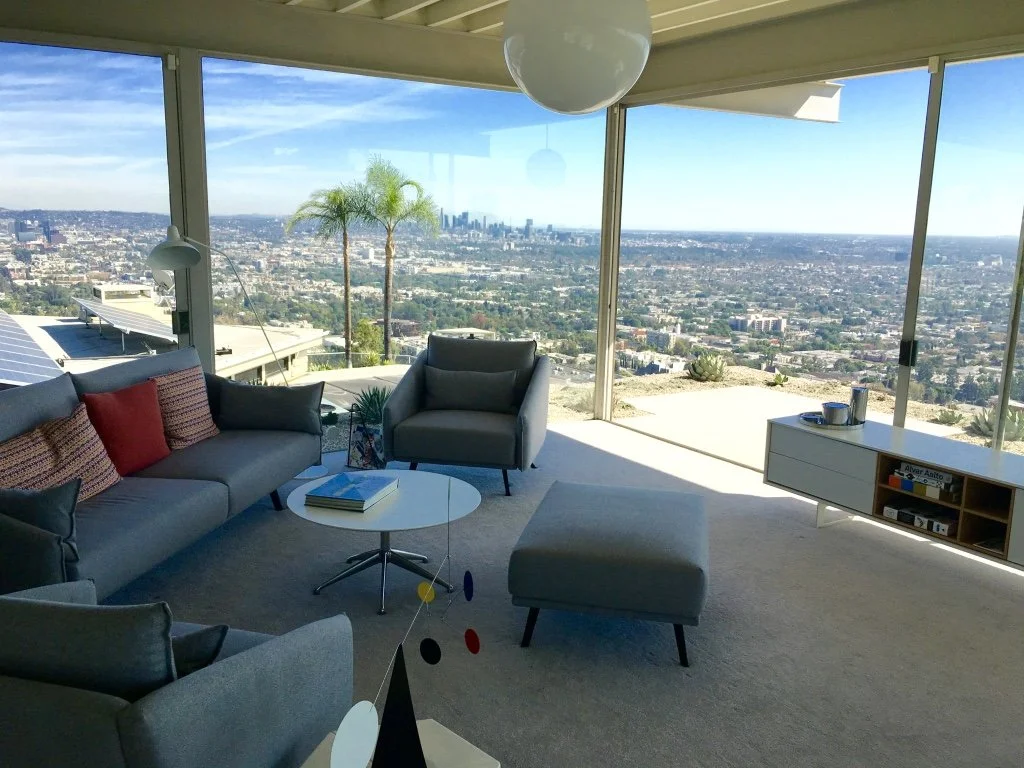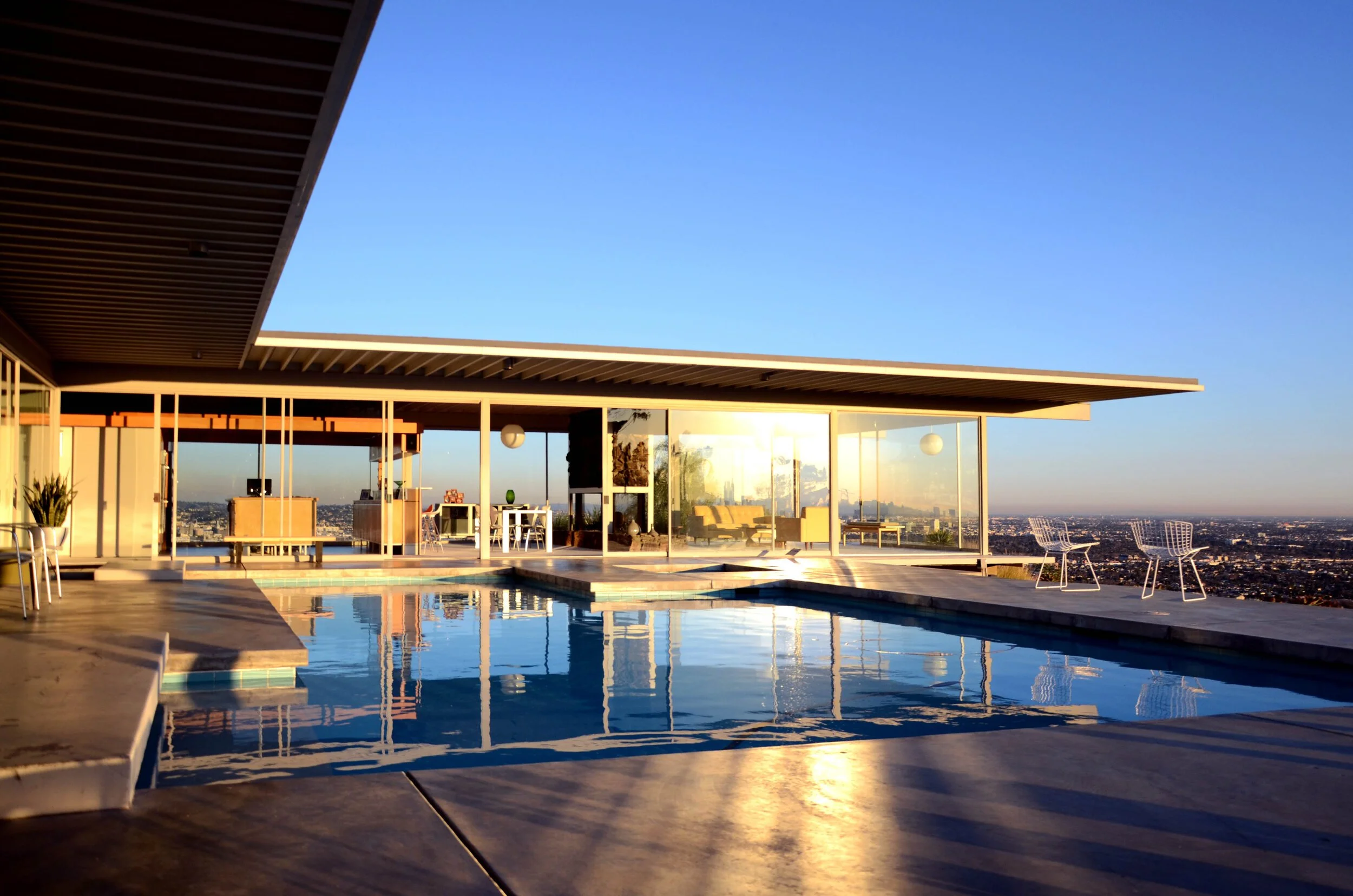The Stahl House: The Dreamlike Symbol of Mid-Century Modernism
Some houses don’t just exist—they capture an era, a lifestyle, and an entire philosophy of design. The Stahl House (Case Study House #22) is one of them.
Julius Shulman/Getty Research Institute, © J. Paul Getty Trust
If you’ve ever seen an image of a house perched above Los Angeles, its glass walls revealing a sleek interior with two people casually lounging as the city sprawls endlessly below them—you’ve seen the Stahl House.
For me, this house is more than just an architectural marvel. I actually went to see it (from the outside, unfortunately) in 2005, and even from that vantage point, I was completely captivated. The way it balances weightlessness with structure, openness with privacy, city life with tranquility—it’s the ultimate mid-century modern home. It’s a symbol of an era when optimism, progress, and sleek design ruled. And it’s one of the most famous and photographed homes in the world for a reason.
Let’s dive into the story of the Stahl House—how it came to be, why it’s still relevant, and what makes it a dream house for so many design lovers like me.
The Origins: How a Family’s Dream Became an Icon
The Stahl House is part of the Case Study Houses, an ambitious post-war program launched by Arts & Architecture Magazine in the 1940s. The idea was to create affordable, modern homes that could be mass-produced for returning soldiers and their families.
In the late 1950s, Buck and Carlotta Stahl, a regular working-class couple, bought a steep and nearly unbuildable plot of land in the Hollywood Hills. The piece of land cost them just $13,500 at the time, and neighbors laughed at them for thinking they could put a house there. But Buck had a vision—he saw a glass house, floating above the city, blending seamlessly with the horizon.
Photo: The Modern Postcard
Enter Pierre Koenig, a modernist architect known for his mastery of steel and glass. With a shoestring budget and an impossibly steep lot, he set out to create something extraordinary. The result? A house that looks like it’s defying gravity.
The Design: A Masterpiece of Mid-Century Modernism
The Stahl House is pure mid-century modern magic. Every element of its design embodies the era’s core principles:
Minimalism & Functionality: The house is a simple rectangle—steel, glass, and concrete. No unnecessary ornamentation, just pure function.
Indoor-Outdoor Living: The glass walls blur the line between inside and outside, making nature a part of the home.
Floating Effect: The way the house extends over the hill, with a cantilevered deck, makes it feel like it’s hovering over LA.
Structural Ingenuity: The steel frame construction allows for those massive, uninterrupted glass panels—something that was revolutionary at the time.
Koenig was known for his industrial approach to homebuilding. He didn’t want fussy materials—he wanted raw, honest elements like steel and concrete to shine. The result? A house that is both ultra-modern and timeless.
Photo: Qoca Architecture
Why Is the Stahl House So Famous?
It’s the Most Photographed Modernist Home in the World
The Stahl House is arguably the most photographed modern home in history.
The most famous shot is Julius Shulman’s legendary 1960 photograph, showing two women sitting inside while the entire city of LA glows beneath them.
That photo is one of the most iconic images of 20th-century architecture—it captured a moment in time, a dream, an idea of effortless modern living.
It Has Been Featured in Countless Films & Ads
The house has been in movies, commercials, and music videos.
Films like Galaxy Quest and Playing by Heart have showcased it.
Brands from Nike to Apple have used it as a backdrop.
It Represents the Golden Age of Los Angeles
The Stahl House is synonymous with LA cool—a city of big dreams and big views.
It captures the effortless luxury of mid-century California living—where modern design met Hollywood glamour.
What It’s Like to Be Inside the Stahl House
Even though I only saw it from the outside in 2005, I’ve spent years dreaming about what it must be like inside. Thankfully, the Stahl House offers public tours, and people who visit often describe it as:
Completely surreal—like stepping into a photograph.
Lighter and airier than expected—the lack of walls makes it feel endless.
Peaceful, yet thrilling—there’s nothing quite like standing at the edge of that deck, watching the world stretch out beneath you.
Carlotta Stahl (who lived in the home until she passed away in 2023) once said that the house “felt like a treehouse”—open and free.
Alison Martino in the Stahl House, Photo: LA Magazine
Why the Stahl House Still Matters in 2025
Even 65 years after it was built, the Stahl House continues to influence architecture and design:
It Proves That Good Design Is Timeless
The house still looks futuristic, even though it was built in 1959. That’s the power of mid-century modernism—clean lines, open spaces, and good materials never go out of style.
It Set the Standard for Indoor-Outdoor Living
Today, everyone wants open-plan homes with floor-to-ceiling windows. The Stahl House did it first.
It’s a Reminder That Big Ideas Can Come from Small Places
Buck and Carlotta weren’t billionaires—they were dreamers. Their vision, combined with Koenig’s genius, created something legendary.
Final Thoughts: My Dream Home
If I could live in any house in the world, it would be this one.
There’s something pure about it. It’s not just beautiful—it feels like an idea, a concept, a way of thinking. It represents optimism, modernism, and a time when architecture was about solving problems in creative ways.
And the fact that I got to stand outside it back in 2005? That was enough to cement it as my ultimate dream house.
If you ever get the chance, take a tour. I promise—it’s one of the most inspiring places you’ll ever set foot in.






